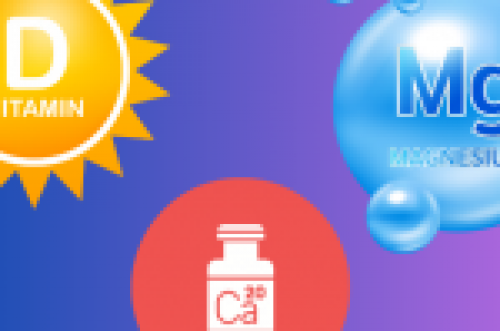The Interaction of Vitamin D, Calcium, and Magnesium

Nutrients don’t operate in isolation; they form a complex interdependent network within our bodies. Among these intricacies, the relationship between vitamin D, calcium, and magnesium is a crucial trio, orchestrating various physiological functions ranging from bone health to cardiovascular stability. However, the balance among these nutrients is delicate, and any disruption can have significant health implications. Understanding their symbiotic relationship is paramount for optimizing health outcomes and preventing deficiencies.
The Essential Triad:
Vitamin D, Calcium, and Magnesium
Calcium and magnesium are indispensable minerals vital for cellular functionality at the core of numerous biological processes. They collaborate extensively, facilitating muscle contractions, nerve impulses, and bone integrity. Concurrently, vitamin D acts as a catalyst, orchestrating the absorption and utilization of these minerals. Together, they form a formidable alliance, ensuring the integrity of our skeletal system and the smooth functioning of vital bodily processes.
Calcium, abundantly found in leafy greens and fortified foods, has witnessed a surge in intake over recent decades. However, magnesium, despite its equal importance, often remains overlooked. Studies suggest that nearly half of the population fails to meet the daily magnesium requirements, predisposing them to an array of health issues—from fatigue and muscle cramps to severe cardiac arrhythmias. Magnesium not only bolsters bone structure but also regulates calcium absorption and potassium transport, underscoring its pivotal role in maintaining overall health.
The Intricate Dance of Ratios:
Calcium to Magnesium Intake
The significance of calcium and magnesium extends beyond their individual intake levels; their ratio holds paramount importance. Research indicates that while magnesium intake has marginally increased, it still trails behind calcium consumption, resulting in an imbalance with a calcium-to-magnesium intake ratio (Ca:Mg) exceeding the optimal range. This imbalance can precipitate adverse outcomes, as excessive calcium intake may compromise magnesium retention, while elevated magnesium levels could impede calcium absorption.
Studies exploring the impact of this ratio on health outcomes have unveiled intriguing findings. For instance, the risk of colorectal cancer exhibited an inverse correlation with magnesium intake among individuals with a baseline Ca:Mg ratio below a certain threshold. Conversely, higher magnesium intake and elevated calcium levels were associated with reduced mortality rates and decreased cancer risks. These observations underscore the nuanced interplay between calcium, magnesium, and disease susceptibility, emphasizing the importance of maintaining an optimal Ca:Mg ratio for overall well-being.
The Vitamin D Nexus: Magnesium’s Crucial Role
In vitamin D metabolism, magnesium emerges as a linchpin, facilitating the synthesis, transport, and activation of this essential vitamin. Inadequate magnesium levels can impede vitamin D metabolism, curtailing the production of active vitamin D forms critical for calcium absorption and bone health. Consequently, individuals with suboptimal magnesium status may exhibit compromised responses to vitamin D supplementation, hindering its efficacy in enhancing bone density and mitigating deficiency-related ailments.
Navigating the Nutritional Terrain: Ensuring Co-Nutrient Sufficiency
Amidst the intricate tapestry of nutrient interactions, ensuring adequate co-nutrient intake is a cornerstone of nutritional well-being. Incorporating magnesium assessment alongside vitamin D evaluation enables a holistic understanding of one’s nutritional status, facilitating informed supplementation strategies tailored to individual needs.
Charting the Course Towards Optimal Health
In a landscape characterized by widespread vitamin D insufficiency and imbalanced nutrient ratios, proactive measures are imperative to safeguard health and vitality. Embracing a multifaceted approach encompassing dietary diversification, targeted supplementation, and vigilant monitoring of co-nutrient status paves the path toward achieving nutritional equilibrium. By acknowledging the synergistic interplay of vitamin D, calcium, and magnesium, we empower ourselves to harness the transformative potential of nutrition, fostering a resilient foundation for lifelong wellness.
The relationship between vitamin D, calcium, and magnesium transcends mere nutritional synergy—it embodies a harmonious convergence of biochemical intricacies essential for vitality and longevity. By unraveling the nuances of this co-nutrient symphony, we unlock the keys to optimal health, empowering individuals to thrive.
References
-
“Effect of Calcium and Magnesium on Inflammatory Cytokines.” National Center for Biotechnology Information, 7 Jan. 2022, ncbi.nlm.nih.gov.
-
“Essential Nutrient Interactions: Does Low or Suboptimal Magnesium.” National Center for Biotechnology Information, 7 Jan. 2016, ncbi.nlm.nih.gov.
-
“Vitamin D and Calcium in Osteoporosis, and the Role of Bone.” National Center for Biotechnology Information, ncbi.nlm.nih.gov.
-
“Vitamin D, Magnesium, Calcium, and Their Interaction in Relation to.” National Center for Biotechnology Information, 19 Mar. 2020, ncbi.nlm.nih.gov.
-
“The Effects of Magnesium-Zinc-Calcium-Vitamin D Co-Supplementation.” National Center for Biotechnology Information, 29 Mar. 2019, ncbi.nlm.nih.gov.
-
“The Effectiveness of Vitamin D3 Supplementation in Improving.” National Center for Biotechnology Information, 6 Oct. 2023, ncbi.nlm.nih.gov.
-
“Magnesium Status and Supplementation Influence Vitamin D.” National Center for Biotechnology Information, 12 Dec. 2018, ncbi.nlm.nih.gov.
-
“Divergent Effects of Sex and Calcium/Vitamin D Supplementation on.” PubMed, 14 Nov. 2022, pubmed.ncbi.nlm.nih.gov.
-
“Personalized Magnesium Intervention to Improve Vitamin D.” National Center for Biotechnology Information, 12 Dec. 2018, ncbi.nlm.nih.gov.
-
“Vitamin D, Essential Minerals, and Toxic Elements.” National Center for Biotechnology Information, 12 Jul. 2015, ncbi.nlm.nih.gov.



